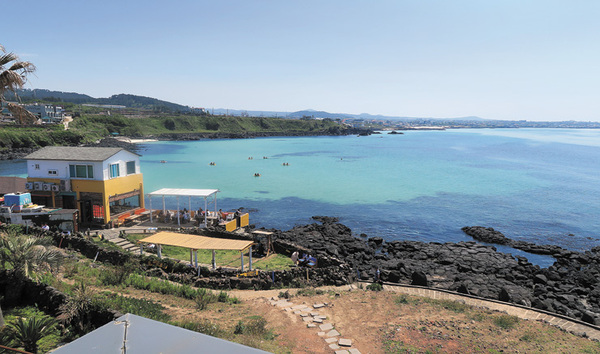
The country's southern island of Jeju is popularly known as "Samdado," translated as "an island abundant with three things" — stone, wind and women.
It may have been true back in the day, but the latter isn't quite accurate as recent statistics reveal the number of men has exceeded that of women in Jeju since 2015. According to a Statistics Korea report released in April, there were 324,435 men (excluding foreigners) as of March compared with 320,489 women.
While the statement about women no longer applies, something else is becoming abundant — gourmet food.
Jeju had long been popular for its seafood and black pork, but it wasn't exactly a fine dining destination. Most of its restaurants provided casual dining for locals, stop-and-go style, or for groups and families.
But the quality of food available on Jeju has reached another level, as evidenced by the list of restaurants participating in the Jeju Gourmet Week as part of the Jeju Food and Wine Festival (JFWF). Gourmet Week ran from May 11 to 20, while the JFWF was held for four days from May 17 to 20.
When this reporter arrived on Jeju on May 17 to attend the JFWF opening event, Gourmet Week was already midway through. Knowing there wasn't much time and lots to explore, this reporter was determined to visit at least two of the 50 participating restaurants of Gourmet Week in her spare time.
Eel sushi offered as omakase at Sushi Hoshikai in Jeju City / Korea Times photo by Yun Suh-young
She decided to go with the most top-notch, wallet-shrinking option, which she knew she couldn't visit too often, as her choice for lunch. It was Sushi Hoshikai, a sushi restaurant touted as the best Japanese restaurant on Jeju and the island's first Japanese fine-dining establishment.
It was an abrupt decision because she wasn't sure what time she would arrive, but there were seats available at the counter — hence, the chef-served omakase option. Chef Lim Duk-hyun, who was also participating in the garden dinner at Maison Glad for the JFWF festival on May 19, was there, busy making sushi for four female guests.
Lim — after being educated at the Tokyo Cooking Academy, one of Japan's best culinary institutes — spent seven years as a chef at Hotel Okura, Hotel Intercontinental Tokyo, and at Niigata Grand Hotel, before returning to Seoul to be trained by Ahn Hyo-joo, the best sushi master in Korea. Following his experience under Ahn, he returned to his hometown Jeju in 2014 and opened his own fine-dining sushi restaurant, using the freshest ingredients from the Jeju waters.
The restaurant is in a mid-city location on a highway, and customers have to park on the side of the road.
The place was small but clean and modern, and the sushi Lim served one by one was meticulously taken care of, considering each customer's preference and taste. It was truly a rare dining experience on Jeju, and one that I had been longing for, away from the crowded seaside hoejjip and barbecue houses.
"The customers here are mostly young, in their 30s and 40s, and many of them are women," Lim said. "I guess this type of restaurant is more suited for young people."
He gently answered every question despite being busy, remembering the sequence of sushi to be served. Although omakase in Japan starts all at once, in Korea there is more flexibility. Even if people arrive at different times, the chef would cater for them.
"The omakase has a sequence, from the lightest to the heaviest," Lim said. "So the fattier fish comes at the end. In Japan, they all start at the same time for convenience. Some people are turned back because they're late, but here that can never happen. Koreans cannot accept that."
Asked if there are foreign customers, he said not many. With wholehearted support to introduce this restaurant to a foreign audience, this reporter headed to her next engagement, where she would taste traditional Jeju cuisine at the JFWF opening ceremony.
A green tea eclair by patissier Lee Hyun-hee presented at the JFWF /Courtesy of JFWF
A Jeju pig filet mignon with citrus sauce by chef Laurent Dallet presented at the JFWF /Courtesy of JFWF
The following day, after breakfast at the hotel, this reporter was scheduled to interview two chefs at the Monsant de Aewol on the island's northern shore. The cafe was apparently owned by G-Dragon, leader of boy band BIGBANG, and served sandwiches, pastries and drinks. There this reporter conducted a brunch-accompanied interview with Laurent Dallet, owner-chef of French restaurant Le Chef Bleu in Chungjeongno, Seoul, and Lee Hyun-hee, owner-patissier of Dessertree in Cheongdam-dong, Seoul. The two were participating in the festival for the first time.
The venue was a unique stone building right by the beach. It was already popular for its owner's fame, but the sandwich was of a quality that could have been found in Cheongdam-dong, the posh district of Seoul.
"I'm impressed by the quality of bread in Korea these days," said chef Dallet, who is from Normandy, France. "A few years ago, this wouldn't have been possible. But now this isn't different from what we'd find in France."
When asked if Jeju was attractive enough to open a restaurant, he said: "Regarding the ingredients, I would. I like the nature. I love sea. I'm from Normandy, the north coast of France. But are there customers for it? This I don't know. But I think it could work in a casual bistro style."
Following lunch, this reporter had a couple of hours to spare before her next appointment. Inspired by patissier Lee's interview (which will be published on another date), this reporter decided to visit French dessert cafe The Simple in Seogwipo, in the island's south.
Driving about 45 minutes from north to south to get a dessert, thinking "this is crazy," she arrived at a small cafe that had a full window facing the street. Inside, there was the promotional dessert for Gourmet Week — a vanilla bean and green tea millefeuille. It was a collaboration between owner-patissiers Seong Hyun-ah, from dessert cafe Sona in Seoul, and Park Jin-sun, from The Simple. Seong was scheduled to serve the gala dinner's dessert for the festival on May 20.
Seong studied at the Culinary Institute of America and Park studied at Le Cordon Bleu Sookmyung Academy. Park makes desserts with ingredients unique to Jeju. The collaboration came after Seong visited Park's dessert cafe last year on her visit to Jeju for the JFWF.
Vanilla bean and green tea mille feuille at dessert cafe The Simple in Seogwipo, Jeju / Korea Times photo by Yun Suh-young
The Simple is one of Jeju's rare dessert cafes serving French pastries, from breads baked in the morning to macarons and millefeuille.
Eating half and taking the rest, this reporter was on the road again. Her last supper was not gourmet-style, but casual raw fish at Moseulpo Haendoro Sikdang in Jeju city. The place is famous for raw mackerel served with seaweed to wrap it. It wasn't fine dining, but equally delicious.
The festival's final gala dinner was served at the Haevichi Hotel in Seogwipo on May 20, which this reporter was unable to attend. The hotel is famous for its French fine-dining restaurant Milieu. She couldn't make it during the festival, but there may be an opportunity to taste the restaurant's delights in Seoul. Today, the Milieu will hold a pop-up fine-dining event at the Italian restaurant Volpino in Cheongdam-dong.
다른 곳에 퍼가실 때는 아래 고유 링크 주소를 출처로 사용해주세요.

